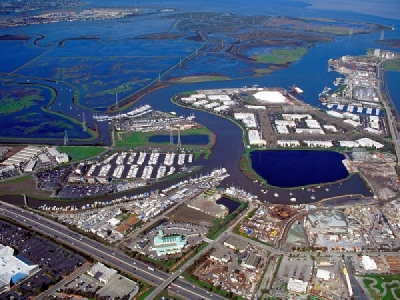
Posted on March 23, 2017
By Anna Schuessler, Daily Journal
As the implications of President Donald Trump’s proposed federal budget take shape, leaders of local government agencies are wondering how potential cuts to federal funding might play a role in their next steps.
Among those grappling with the possibilities is Mike Giari, executive director of the Port of Redwood City, for whom proposed cuts to federal infrastructure programs and what they might mean for maintenance dredging the port has scheduled with the U.S. Army Corps of Engineers are top of mind.
“We’ll be following this very closely,” he said. “It’s a proposed budget so what the final outcome is going to be is uncertain.”
Though the proposed plan is still early in the process and expected to change through committees and debate in both houses of Congress before it gets to Trump’s desk for signature, that hasn’t stopped some from attempting to forecast the budget’s effect on other government agencies. In a press release issued Thursday by the American Association of Port Authorities, Kurt Nagle, AAPA president and CEO, emphasized the crucial role ports play in commercial activities.
“Activities at U.S. seaports account for more than a quarter of the nation’s economy, support over 23 million American jobs and generate more than $320 billion a year in federal, state and local tax revenue,” he said in the press release. “It’s vital the federal government uphold its end of the partnership with ports so the country can have a 21st century goods movement system in place.”
In the press release, the AAPA mentioned dock and road improvements and security enhancements, among other measures implemented by agencies such as the Department of Transportation, the Department of Homeland Security and the U.S. Army Corps of Engineers, supporting port operations across the United States.
How the budget process might affect the U.S. Army Corps of Engineers’ ability to dredge the Redwood City shipping channel is most urgent for Giari. Ensuring the port’s water is deep enough to accept large vessels loaded with heavy materials, which might otherwise sink or get stuck in Bay mud, allows the port to accept a range of vessels at its docks. In recent years, the port has become a destination and critical loading point for vessels transporting concrete and building materials slated for construction projects in and out of the Bay Area.
Giari said he expects the future for the port’s dredging project, which is scheduled for September and October, to remain uncertain until the U.S. Army Corps of Engineers sets its budget, which is expected to take the federal budgeting process into account, in May. Because the U.S. Army Corps of Engineers typically begins an environmental review and bidding process for an operator a few months prior to the project’s start date, Giari expressed concern about the uncertainty the proposed budget is creating for a project with several steps.
“It’s compounded a little bit by the fact that there’s an environmental window for dredging in the Bay Area,” he said.
Giari also noted the environmental window sketched by a group of federal and state agencies outlining the period of time, roughly from June or July to December, when dredging would minimally affect marine life in the Bay. If the dredging project is pushed much farther beyond its scheduled start date, the port may be forced to request an extension to the environmental window, which could delay the project even further.
Among the other organizations whose budgets Giari plans to keep an eye on are the U.S. Coast Guard, with whom the port works closely to ensure the port is secure, and other Bay Area ports. In conjunction with the U.S. Coast Guard, the port has developed a maritime security plan mapping out everything from lighting and surveillance cameras at the port to emergency preparedness equipment and training for port staff and those working on docked vessels. Giari noted the critical role the agency plays in placing aids to navigation, such as lights, buoys and other markers, throughout the Bay, letting those navigating ships know where they are no matter what time of day it is. Giari said that budget cuts to the Coast Guard, as well as any other Bay Area ports such as the Port of San Francisco, Port of Oakland and Port of Richmond, would have an effect on all of the other organizations involved with operating vessels in the Bay Area.
“That concerns us because we work together with the other ports in the Bay Area,” he said. “[Whether] they have funding for projects that are necessary, it impacts the industry generally and the whole Bay Area.”
Though Giari acknowledged the limitations of projecting too far in the future given the many steps ahead for the budgeting process, he said the port could also see the effects of the cuts should the economy shift for construction projects or building materials, two of the industries driving the port’s activities.
“If that commerce is restricted or affected, it could affect those jobs downstream,” he said
Source: Daily Journal





